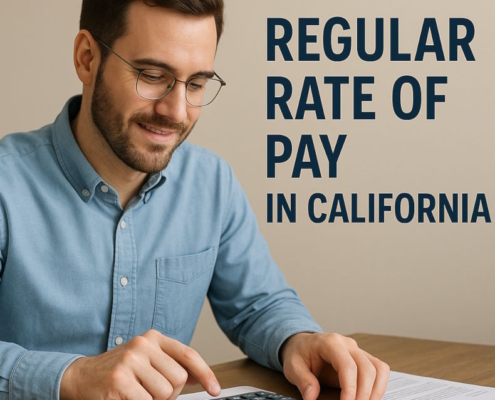What is the PAGA statute of limitations?
Since its passage twenty years ago, the Private Attorneys General Act of 2004 has emerged as a crucial tool for the state’s application of its Labor Code. In order to accommodate California’s rapidly expanding workforce, PAGA augments state efforts to enforce compliance with the Labor Code by appointing workers who have been accused of violations to act as stand-ins for the state. For a variety of penalties, including those pertaining to wage and hour violations, PAGA is a popular, well-established, and powerful tool for complainants to sue the state and other entities.
Following court decisions upholding arbitration agreements’ class action waiver provisions, a deluge of PAGA claims, which includes so-called “PAGA only” claims that did not include a class action, descended upon the system. After much back-and-forth, a compromise was made to introduce reforms, meaning that PAGA would be modified and the repeal ballot proposal would be removed from the November 2024 vote. The latest version of PAGA is an attempt to settle a few of the complaints voiced by corporate interests.
Origins and goals: the LWDA’s function
Benefits administration and labor law enforcement are responsibilities of the California Labor and Workforce Development Agency (“LWDA”). In cases where a person violates PAGA and the California Labor Code, the LWDA is responsible for issuing and collecting civil penalties.
Workers in California can sue their employers for penalties under PAGA because the LWDA couldn’t handle the state’s expanding workforce. However, they must first inform the LWDA about a PAGA violation; if the LWDA decides not to take action or investigate, then workers can sue. If the LWDA does not respond within sixty-five days of being notified, the worker can go ahead and file a lawsuit.
The purpose of enacting legislation
The legislature voiced anxiety about the LWDA’s ability to enforce labor laws and recover penalties due to the agency’s understaffed levels, which had failed to keep pace with the expanding economy.
The major goal of PAGA was to enforce the Labor Code using the state’s police powers, not to safeguard employees’ financial interests. This is because under PAGA, the LWDA received 75% of the penalties, while the aggrieved employees only kept 25%.
An overview of PAGA: claims covered by PAGA
There are three main types of PAGA violations: (1) those that violate the provisions listed in Section 2699.5 of the Labor Code; (2) those that violate health and safety regulations set by OSHA and (3) any other provisions of the Labor Code that are not in the first two types.
Common claims that fall under PAGA’s purview include those involving inadequate breaks for meals and rest, unpaid overtime, incorrect classification, and unreimbursed essential costs.
Excluded claims under PAGA
PAGA does not grant individuals the legal authority to sue for unpaid wages or to impose wage orders directly. Moreover, the statute does not cover the following: (1) claims of violations of Labor Code notice, posting, filing requirement, or agency reporting (with the exception of required workplace injury or payroll reporting); (2) recovery of civil and administrative penalties related to workers’ compensation actions; (3) claims of violations of the California Labor and Workplace Development Agency’s inaction.
1. Standing
It used to be that any aggrieved worker could file a PAGA claim on behalf of any other worker at the same company. Any worker who was allegedly the victim of a PAGA violation was considered an aggrieved worker. It was not necessary for the wronged workers to share any characteristics. The recent reforms have addressed this issue.
2. Statute of limitations
You have up to a year from the most recent infraction to file a PAGA claim. Prior to submitting a lawsuit, employees are required to wait the 65-day period of review, during which the LWDA has the option to intervene. During the 65-day waiting period, the statute of limitations is tolled.
In addition to statutory damages, PAGA also allows civil penalties. It is possible for aggrieved workers to seek statutory damages and civil penalties in their separate capacities if they file separate wage claims and PAGA claims.
When it comes to wage and labor violations, PAGA’s civil penalties are distinct from the statutory damages that were formerly available to employees individually. The plaintiff-worker keeps a small portion of the civil penalties awarded to the state under PAGA, while the plaintiff-employee receives statutory damages to compensate them for their damages, which means they pay the owed wages.
PAGA does not stop employees from seeking other legal options under federal or state law, either on their own or at the same time as a PAGA action. Court cases have explained the difference between asking for penalties under the Labor Code for company wage and hour infractions, which employees could recover before PAGA was added, and asking for “civil penalties,” which could only be enforced by state labor law departments before.
3. Determination of civil fines
The PAGA system determines and issues civil penalties on a per-pay-period basis for each employee. In the past, this hurt businesses that paid their employees on a weekly basis because the penalties were much higher for the same amount of time because there were more pay periods in a year. Unless otherwise specified in the Labor Code, the default penalty under PAGA is $100 for each pay period for the first infraction and $200 for each pay period for any later infractions. The timing of the succeeding penalty rates was the subject of extensive litigation.
PAGA trials: chances of prevailing in court
Few PAGA cases have actually reached trial, regardless of the recent uptick in PAGA lawsuits. Recent research shows that there have been seventy-eight PAGA trial judgments over the past 20 years, but there are probably more than that. In the available cases, trial courts found violations of labor laws in about 70% of them. However, since the courts did not give PAGA penalties in eight of these cases, the success rate was under 60 percent.
At trial, allegations of inaccurate wage statements were likeliest to be successful.
There is a high success rate for lawsuits that solely claim that wage statements are inaccurate. PAGA retaliation cases also tend to have better results. Cases that involve multiple violations, like break violations, wage loss, and unreimbursed expenses, tend to have a more even distribution of outcomes. Suitable seating cases have both successful and unsuccessful outcomes. However, it is common for suitable seating cases to end in settlements, and both parties often consider early resolution to be preferable.
Trial verdicts with the highest penalties
Cases involving numerous unrelated violations have typically resulted in heavier punishments. Paystub violations were less often awarded, even though they were simpler to prove. Courts consider the employer’s willingness when deciding whether to reduce awards, taking into account factors like prior grievances, the company’s difficulties in fixing wage statements, and the absence of harm. In fifty-five percent of cases where infringements were found, trial courts reduced penalties. The value of these reductions depended greatly on the particular circumstance.
Combining PAGA penalties
Whether or not PAGA permits the stacking of penalties, and to what degree, is a matter of heated controversy. Stacking PAGA penalties is when courts impose multiple civil penalties on an aggrieved worker for separate but related wrongful conduct within the same pay period. Plaintiffs’ attorneys often ask for this sort of thing as well. Recently implemented reforms have addressed this issue.
Changes to PAGA and its most recent updates
The ease with which wronged workers can use PAGA claims—especially PAGA-only claims—to get settlements, which mainly benefit plaintiffs’ attorneys, has led to severe criticism of PAGA.
There have been revisions to the Act since its beginning in response to persistent criticisms. The latest attempt to save PAGA from total repeal in 2024 was to make reasonable, practical changes.
The Development of PAGA
In 2004, fewer than two months after it became effective, PAGA underwent its first round of amendments. The goal of these revisions was to make it harder to use PAGA lawsuits for nothing while still making it easier to enforce wage and hour laws. As per the 2004 PAGA amendments, in order for an employee to seek penalties under PAGA, they must first write a letter to the LWDA outlining the facts and explanations for the claimed Labor Code violations.
In an effort to increase LWDA’s supervision and engagement, PAGA amendments made in 2016 lengthened the time one had to wait before submitting a PAGA complaint. Any court order or judgment that awards or denies civil penalties, as well as communication of any planned PAGA settlement, must be given to the LWDA, per the 2016 PAGA amendments. Additionally, those amendments broadened PAGA’s cure provisions, giving employers an opportunity to correct specific technical infractions (like specific kinds of wage statement errors) before the claimant can initiate litigation.
Most recent changes
Governor Newsom signed AB-2288 and SB-92 into law on July 1, 2024. These bills, among other things, make changes to PAGA, such as reducing penalties, prioritizing remediation and cure over court proceedings, strengthening the manageability requirement, expanding remedies, encouraging audits, and enforcing the standing requirement. They also award a larger portion of the fines to the plaintiff-worker.
1. New reforms do not apply to past situations
The new rules will be enforced for all PAGA cases that are initiated after June 19, 2024, and specifically for cases where the LWDA Notice was issued on or following that date.
2. Clarification on the one-year statute of limitations
Claims under PAGA are subject to a one-year statute of limitations. Different state courts had different interpretations of this prior to the reform. It used to be that an employee who was “aggrieved” by a Labor Code breach (even if it happened before the PAGA timeframe or was otherwise time-barred) could bring a claim on behalf of others. However, this is no longer allowed under the new rules; PAGA complainants must have experienced infractions during the statute of limitations timeframe of one year.
3. Elimination of derivative penalty stacking
Derivative penalties under Sections 201, 202, 203, 204, and 226 of the Labor Code cannot be stacked as a result of the reforms. However, extra penalties can be pursued for failing to supply a wage statement or for conscious or intentional violations.
4. Prompt assessment and treatment
To fix infractions, big and small businesses follow different procedures. During the PAGA period, businesses with fewer than one hundred employees have the option to submit a private proposal to the LWDA in order to address any allegations of violations and participate in any negotiations regarding these matters. During the PAGA period, companies with 100 or more employees have the option to ask for an early assessment conference.
During this conference, they can ask for a hold on court proceedings and state whether they plan to cure. The court will then appoint an impartial assessor to assist in reaching a resolution. Keep in mind that the cure and notice provisions are only applicable once every twelve months for the same kind of infractions. Some Labor Code violations can be remedied, but there is a catch: the standard for “whole” is quite high.
However, there are now more infractions that can be remedied, such as not paying the minimum wage or overtime, not reimbursing expenses, not providing rest and meal breaks or paying premiums for the same, and expanding parts of the wage statement law.
In the past, employers faced heavy fines for incorrectly listing the address and name of their entities. The reform made it clear that this is fixable; instead of providing new wage statements for each relevant pay period, it is sufficient to provide written notice to each employee who feels wronged.
In addition to paying the employee’s wages in full for the last three years, the company also has to make the worker “whole” by paying the statutory minimum of liquidated damages, 7% interest, and appropriate legal expenses and fees. If an employee challenges their pay, the employer may be required to pay a sum equal to the amount of back wages awarded by the LWDA Court.
To bring a PAGA lawsuit for the benefit of other wronged employees, one must have suffered a particular violation in order to do so.
Before the new changes, a current or previous employee could file a PAGA lawsuit against their company for violations they personally did not experience. An employee could start a case for any PAGA violations affecting themselves or their co-workers, even if they had not personally faced all the alleged issues.
Now, in order to seek penalties for rest break violations under PAGA, an aggrieved worker must have personally experienced each of the infractions claimed. This means that an employee who does not endure a rest break violation cannot bring a PAGA suit. In the fight to limit the reach of PAGA cases, this is a major victory. The new rule does not affect current nonprofit legal aid companies. This encourages lawyers for plaintiffs to team up with these nonprofits when filing claims.
5. Separate procedure for wage statement cure
Before the new PAGA rules, there were two kinds of wage-statement breaches that could be remedied:(1) failing to specify the dates that encompass the employee’s pay period and (2) failing to detail the employer’s legal entity. An employer can now rectify the first infraction by giving each affected employee a concise written notice that specifies the correct information.
If an employer wants to fix any other violation, they have to give the affected workers the updated wage statements for every pay period in the last three years where the violation happened. In addition, the new reform makes it appropriate to provide corrected wage statements electronically.
If a wage statement violation is the sole infraction at issue, employers are required to follow a different cure procedure starting on or after October 1, 2024. In addition to rectifying the wage statement infringement, employers must first notify the PAGA plaintiff in writing through certified mail and then submit an online notice to the LWDA. Within thirty-three days after the PAGA notice’s postmark date, the LDWA must receive the filing detailing the actions done to cure. A PAGA complainant may initiate a court action if the infractions are not remedied after thirty-three days.
An employee who disagrees with their wage statement’s accuracy must notify both their employer and the LWDA in writing of their disagreement, providing specific reasons in support of their stance. The LWDA is required to evaluate the employer’s remedy and notify the employee and employer in writing of its decision no later than seventeen calendar days after receiving such a notice.
Depending on the severity of the violation, the LWDA may grant the employer an extension of three business days to resolve the issue. The PAGA plaintiff has the right to sue if the LWDA believes the error was not remedied or if it does not notify the plaintiff of its decision. The employee has the right to file an appeal with the superior court if he or she disagrees with the LWDA’s treatment of the violation as cured.
6. Numerous cases saw reductions in PAGA penalties
In a number of cases, the new rules indicate lighter punishments:
- For specific infractions, the penalty is $50 for each pay period per affected employee (the lesser of thirty days or four pay periods, whichever is less) if the employer can prove the violation is unique and does not occur again.
- A wage statement infraction under Section 226 of the Labor Code can only result in a $25 civil penalty per worker per pay period if the plaintiff is not harmed by the breach (i.e., if the worker could easily interpret the necessary info from the wage statement or if the absence of company identity information does not cause confusion).
- To even out the “per pay period” penalty amounts in cases where a company does not use semimonthly or biweekly pay periods, the penalties for week pay periods are cut in half. (As an example, many service technicians are paid weekly; a $100 infraction used to result in $400 per month for each employee who was wronged, but now it’s decreased to $200 per month, the same as for semi-monthly pay periods).
7. A larger portion of the penalty goes to the employees
The previous split was 25/75, but now the LWDA will get 65% and the employees 35% of the net settlement or penalty.
8. An established standard for manageability
In the past, employers would argue that PAGA claims were too broad and difficult to handle, thus limiting their scope. The decisions in Wesson v. Staples the Office Superstore and Estrada v. Carpet Royalty Mills, Inc. were at odds with one another prior to the PAGA reform, specifically regarding the possibility of a motion to terminate a PAGA claim prior to trial on the grounds that it is unmanageable.
There can be no pre-trial dismissal of PAGA claims on the grounds that the evidence will be too overwhelming to handle, according to the California Supreme Court. With the new PAGA reform in place, employers can now make the case that plaintiffs in PAGA trials need to be able to present manageable amounts of evidence. This should give courts the additional assurance they need to check the amount of evidence heard.
9. You can now get injunctive relief
Injunctive relief is a broader remedy. Employees are not obligated to pursue injunctive relief under PAGA, but the law does allow it.
10. Employers can limit their penalties by taking “all reasonable steps” to guarantee compliance
The maximum penalty for a PAGA violation is 15% of the penalty amount if the employer was determined to have done their due diligence to ensure compliance with the law prior to receiving a request for personnel records under Section 226, 432, or 1198.5 or a PAGA notice.
Second, PAGA fines for infractions can’t exceed 30% of the relevant penalty amount if the employer was determined to have done all they could to comply with the law within 60 days of getting a PAGA notice.
Consideration of all relevant factors determines whether a company acted reasonably. Some examples of reasonable actions are:
- Officially communicating policies in writing
- Performing routine payroll audits and fixing problems
- Compliance training for management
- Taking steps to address issues with supervisors
11. Implementation worries
There is a long way to go before the reforms are considered perfect, but they are an improvement. Their implementation is fraught with uncertainty, and even with good intentions to promote compliance, they will inevitably result in complicated legal disputes.
Guidelines for maintaining compliance
To be sure they are in compliance and making the most of the changes, employers must now examine their practices, rules, and procedures.
1. Hold audits on a regular basis
Businesses should routinely audit their operations to check for typical PAGA infractions like unpaid overtime or problems with rest and meal breaks if they want to remain in compliance. Auditing internal procedures such as pay stubs, job descriptions, and pay transparency measures (job postings, paperwork, etc.) can help employers avoid heavy penalties and demonstrate their sincere effort to comply with the Act. In addition, businesses need to act swiftly and record the procedure when they find a PAGA-actionable infraction.
2. Formulate and implement official policies
The next step is to draft and implement policies that govern wage and hour practices in writing. It is important to create policies, communicate them to your employees in writing, and consistently enforce compliance, whether it’s through training sessions, policy revisions or additions, or disciplinary actions for repeated infractions.
3. Keep documents
Keep all records and files pertaining to personnel, applications, membership, or employment referrals for at least four years following their creation or receipt. If employers do not keep personnel files of terminated employees and applicants for at least four years following the date of the employment action, then they are in violation of the law.
4. Prepare supervisors and workers
Both management and staff should undergo regular training to stay in compliance with all legal requirements. Notify upper management of the anti-retaliation statutes.
5. Keep an eye on things and review them often
Employers should establish a system to regularly (at least once a year) assess and oversee their rules, procedures, and regulations to guarantee future compliance.
6. Hire experienced lawyers with knowledge of the industry
In order to ensure compliance and smooth implementation, employers should seek the advice of experienced attorneys and stay updated on regulations that are specific to their industry.
The new reforms do not eliminate PAGA’s flaws and even introduce some new ones that will be the subject of future litigation. Nevertheless, they do provide employers and defendants with some relief and strategies to counter these claims.






























